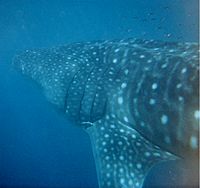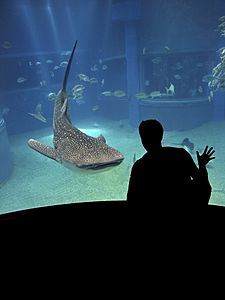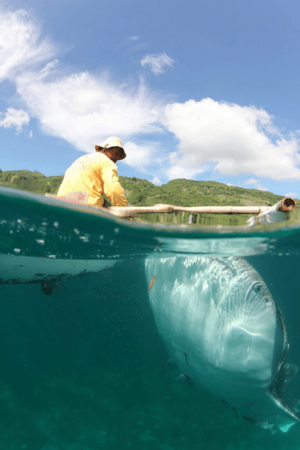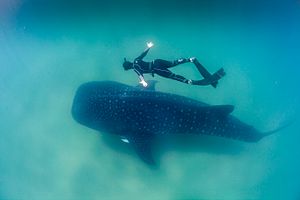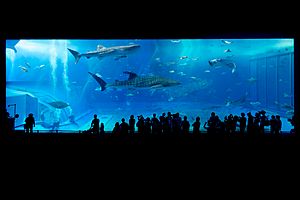Whale shark facts for kids
Quick facts for kids Whale shark |
|
|---|---|
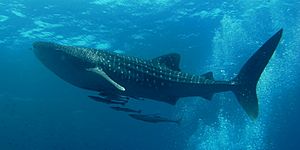 |
|
| Whale shark in the Andaman Sea around the Similan Islands | |
 |
|
| The size of various whale shark individuals with a human for scale | |
| Conservation status | |
| Scientific classification | |
| Genus: |
Rhincodon
|
| Species: |
typus
|
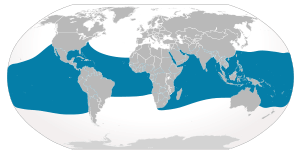 |
|
| Range of whale shark | |
| Synonyms | |
|
|
The whale shark (Rhincodon typus), is a filter feeding shark. It is the largest shark in the world. It grows up to 12 metres long, and may weigh as much as 47,000 pounds.
The whale shark has a very wide distribution, found in all tropical and warm temperate seas, except in the Mediterranean.
Contents
Description
The whale shark has a streamlined body and a wide, flattened head. The mouth is transverse, very large and is nearly at the tip of the snout. The gill slits are also very large, and are designed as filtering screens. The first dorsal fin is much larger than the second dorsal fin, and is located at the back of the body. The caudal fin is semi-lunate (crescent-shaped) in adults, and with the young, the upper lobe is quite longer than the lower lobe. The whale shark has a unique "checkerboard" colour pattern of light spots and stripes on a dark background.
Whale sharks are grey, blue or brown above, with a surface pattern of creamy white spots between pale, vertical and horizontal stripes. The belly is white. The use of the strange pattern on the whale shark is unknown, although many bottom-dwelling Whale sharks use these markings as a camouflage against their backgrounds. They can be as long as 41 feet (12.3 metres) in length, and weigh as much as 47,000 pounds (21.5 tonnes). However, it is believed that there are some whale sharks which can reach lengths of up to 67 feet (20 metres). The smallest free-living individuals are around 55cm (21.7 inches) long. Whale sharks reach maturity at lengths of around 9 metres
Distribution
The whale shark has a very widespread distribution, found in all tropical and warm temperate seas, except in the Mediterranean. It is found throughout the Atlantic Ocean, from New York, through the Caribbean, to central Brazil, and from Senegal to the Gulf of Guinea. It also is found in the Indian Ocean, throughout the region, including the Red Sea and the Arabian Gulf. In the Pacific Ocean it is found from Japan to Australia, off Hawaii, and from California to Chile. Although other shark species of the order Orectolobiformes are benthic (live on or near the bottom), the whale shark lives in the pelagic zone. Studies show that this shark prefers warm waters, with surface temperatures of around 21-30 °C. It is often seen offshore but commonly comes close inshore, sometimes entering lagoons or coral atolls. Whale sharks sometimes swim deeper than 700 metres
Predators
Although the whale shark has no real predator, young Whale sharks have been found in the stomachs of Blue sharks and Blue marlin.
Behaviour
In spite of its large size, the whale shark is timid. Divers usually hold onto the tails of these sharks and swim with them, and the whale sharks never seem to attack. There is some risk that a diver getting too close to a whale shark could get sucked into the filtering system that the sharks use for feeding. Another risk is that they can create problems for small boats that they may accidentally knock into. For the sharks, contact with very large boats can result in severe injuries.
Feeding
With the basking shark and the megamouth shark, the whale shark is one of the three known species of filter feeding sharks. It feeds mainly on plankton and nekton, small crustaceans, schooling fish, and sometimes on tuna and squids. Whale sharks may also sometimes feed on phytoplankton and macroalgae. Unlike most plankton-feeding vertebrates, the whale shark does not depend on slow forward motion to operate its filtration mechanism. Instead, it relies on a versatile suction filter-feeding methodology, which allows it to draw in a larger amount of water than other filter-feeders, such as the Starfish. This allows the whale shark to capture larger amounts of plankton. Whale sharks are always seen feeding in a vertical or near vertical position with the head at or near the surface. Other food items for the whale shark can include krill, and the larvae of Christmas Island red crab.
Reproduction
There is very little information that has been documented about whale sharks mating and giving birth to young. Some whale sharks which live in captivity are studied by scientists but the whale shark is not very common in aquariums due to its large size. However, it is believed that they can have up to 300 pups at a time. This would be considerably more than other shark species, yet only a small fraction of them live to the age of maturity. It is believed that this species of shark doesn’t mate until it is about 30 years old. They can live from 70 to 100 years of age.
Human use
In the past, the whale shark has been of little interest to fisheries. Now, commercial fishing for whale sharks are limited, but may expand from an increased demand for food products. In Taiwan around 100 whale sharks are caught annually. The meat of the whale shark is sold for high prices in this country, and since of this, there have been larger harvests of whale sharks over the last few years. Fishing for this shark also occurs in the Philippines, particularly in the Visayas and Mindanao areas, providing food for the local fishing communities. Whale shark fins are sold in the Orient, especially in Hong Kong. Occasionally, whale sharks are captured accidentally along the coast of India. Sometimes the flesh is eaten and the liver oil is used for waterproofing wooden fishing boats and for the manufacture of shoe polish, and it is also used as a treatment for some skin diseases. The fins of Whale sharks are also sold in India. Often, the whale shark is used as an indicator of waters which are rich in plankton-feeding fish that will, in turn, attract more valuable species, such as tuna. Whale sharks have been kept in aquaria in Japan, but their large size and their diet has made it hard to keep a whale shark in an aquarium. Some locations where the presence of whale sharks appears to be predictable, are increasingly targeted by commercial tourist operations.
Relationship with humans
Behavior toward divers
Despite its size, the whale shark does not pose any danger to humans. Whale sharks are docile fish and sometimes allow swimmers to catch a ride, although this practice is discouraged by shark scientists and conservationists because of the disturbance to the sharks. Younger whale sharks are gentle and can play with divers. Underwater photographers such as Fiona Ayerst have photographed them swimming close to humans without any danger.
The shark is seen by divers in many places, including the Bay Islands in Honduras, Thailand, Indonesia (Bone Bolango, Cendrawasih Bay), the Philippines, the Maldives close to Maamigili (South Ari Atoll), the Red Sea, Western Australia (Ningaloo Reef, Christmas Island), Taiwan, Panama (Coiba Island), Belize, Tofo Beach in Mozambique, Sodwana Bay (Greater St. Lucia Wetland Park) in South Africa, the Galapagos Islands, Saint Helena, Isla Mujeres (Caribbean Sea), La Paz, Baja California Sur and Bahía de los Ángeles in Mexico, the Seychelles, West Malaysia, islands off eastern peninsular Malaysia, India, Sri Lanka, Oman, Fujairah, Puerto Rico, and other parts of the Caribbean. Juveniles can be found near the shore in the Gulf of Tadjoura, near Djibouti, in the Horn of Africa.
Conservation status
There is currently no robust estimate of the global whale shark population. The species is considered endangered by the IUCN due to the impacts of fisheries, by-catch losses, and vessel strikes, combined with its long lifespan and late maturation. In June 2018 the New Zealand Department of Conservation classified the whale shark as "Migrant" with the qualifier "Secure Overseas" under the New Zealand Threat Classification System.
It is listed, along with six other species of sharks, under the CMS Memorandum of Understanding on the Conservation of Migratory Sharks. In 1998, the Philippines banned all fishing, selling, importing, and exporting of whale sharks for commercial purposes, followed by India in May 2001, and Taiwan in May 2007.
In 2010, the Gulf of Mexico oil spill resulted in 4,900,000 barrels (780,000 m3) of oil flowing into an area south of the Mississippi River Delta, where one-third of all whale shark sightings in the northern part of the gulf have occurred in recent years. Sightings confirmed that the whale sharks were unable to avoid the oil slick, which was situated on the surface of the sea where the whale sharks feed for several hours at a time. No dead whale sharks were found.
This species was also added to Appendix II of the Convention on International Trade in Endangered Species of Wild Fauna and Flora (CITES) in 2003 to regulate the international trade of live specimens and its parts.
Hundreds of whale sharks are illegally killed every year in China for their fins, skins, and oil.
In captivity
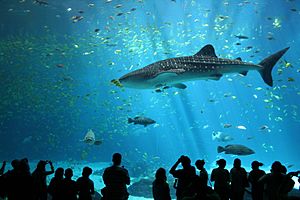
The whale shark is popular in the few public aquariums that keep it, but its large size means that a very large tank is required and it has specialized feeding requirements. Their large size and iconic status have also fueled an opposition to keeping the species in captivity, especially after the early death of some whale sharks in captivity and certain Chinese aquariums keeping the species in relatively small tanks.
The first attempt at keeping whale sharks in captivity was in 1934 when an individual was kept for about four months in a netted-off natural bay in Izu, Japan. The first attempt of keeping whale sharks in an aquarium was initiated in 1980 by the Okinawa Churaumi Aquarium (then known as Okinawa Ocean Expo Aquarium) in Japan. Since 1980, several have been kept at Okinawa, mostly obtained from incidental catches in coastal nets set by fishers (none after 2009), but two were strandings. Several of these were already weak from the capture/stranding and some were released, but initial captive survival rates were low. After the initial difficulties in maintaining the species had been resolved, some have survived long-term in captivity. The record for a whale shark in captivity is an individual that, as of 2021, has lived for more than 26 years in the Okinawa Churaumi Aquarium from Okinawa Ocean Expo Aquarium. Following Okinawa, Osaka Aquarium started keeping whale sharks and most of the basic research on the keeping of the species was made at these two institutions.
Since the mid-1990s, several other aquariums have kept the species in Japan (Kagoshima Aquarium, Kinosaki Marine World, Notojima Aquarium, Oita Ecological Aquarium, and Yokohama Hakkeijima Sea Paradise), South Korea (Aqua Planet Jeju), China (Chimelong Ocean Kingdom, Dalian Aquarium, Guangzhou Aquarium in Guangzhou Zoo, Qingdao Polar Ocean World and Yantai Aquarium), Taiwan (National Museum of Marine Biology and Aquarium), India (Thiruvananthapuram Aquarium) and Dubai (Atlantis, The Palm), with some maintaining whale sharks for years and others only for a very short period. The whale shark kept at Dubai's Atlantis, The Palm was rescued from shallow waters in 2008 with extensive abrasions to the fins and after rehabilitation it was released in 2010, having lived 19 months in captivity. Marine Life Park in Singapore had planned on keeping whale sharks, but scrapped this idea in 2009.
Outside Asia, the first and so far only place to keep whale sharks is Georgia Aquarium in Atlanta, United States. This is unusual because of the comparatively long transport time and complex logistics required to bring the sharks to the aquarium, ranging between 28 and 36 hours. Georgia keeps two whale sharks: two males, Taroko and Yushan, who both arrived in 2007. Two earlier males at Georgia Aquarium, Ralph and Norton, both died in 2007. Trixie died in 2020. Alice died in 2021. Georgia's whale sharks were all imported from Taiwan and were taken from the commercial fishing quota for the species, usually used locally for food. Taiwan closed this fishery entirely in 2008.
Human culture
In Madagascar, whale sharks are called marokintana in Malagasy, meaning "many stars", after the appearance of the markings on the shark's back.
In the Philippines, it is called butanding and balilan. The whale shark is featured on the reverse of the Philippine 100-peso bill. By law snorkelers must maintain a distance of 4 ft (1.2 m) from the sharks and there is a fine and possible prison sentence for anyone who touches the animals.
Whale sharks are also known as jinbei-zame in Japan (because the markings resemble patterns typically seen on jinbei); gurano bintang in Indonesia; and ca ong (literally "sir fish") in Vietnam.
The whale shark is also featured on the latest 2015–2017 edition of the Maldivian 1000 rufiyaa banknote, along with the green turtle.
Related pages
Images for kids
See also
 In Spanish: Rhincodon typus para niños
In Spanish: Rhincodon typus para niños



